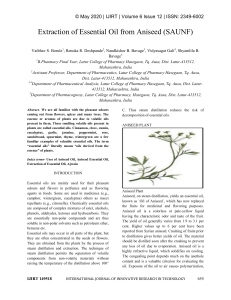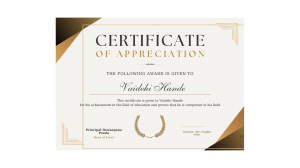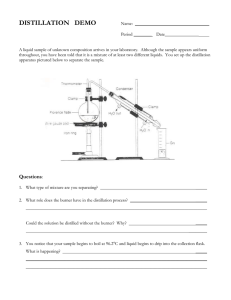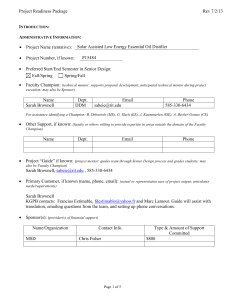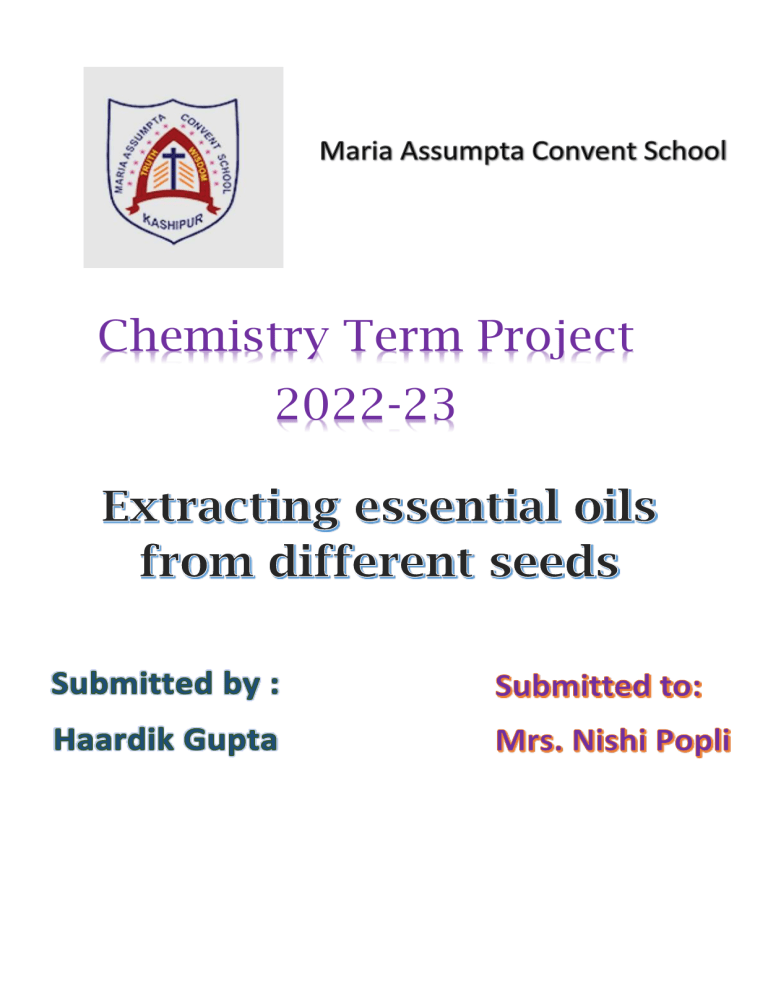
Chemistry Term Project 2022-23 ACKNOWLEDGEMENT I feel proud to present my investigatory project in chemistry on the “To extract essential oil present in Aniseed , Sunflower, Soybean and Canola. I wish to express my deep gratitude and sincere thanks to Father Principal of Maria Assumpta Convent Senior Secondary School for his encouragement and for all the facilities that he provided in this project work. I extent my hearty thanks to Ms. Nishi Popli Ma’am, Chemistry teacher who helped me, gave me moral support and knowledge about the subject and also the library which provided us books for detailed idea about the project. Last but not the least I would like to thank my parents and my friends who gave me complete support and help to do this project. Without all of these people this project would never have been complete. Certificate of Authenticity This is to certify that Haardik Gupta a student of class 12th ‘C’ has successfully completed the research project on the “To extract essential oil present in Aniseed, Sunflower, Soybean, Canola seeds.” under the guidance of Mrs. Nishi Popli. This project is absolutely genuine and does not indulge in plagiarism of any kind. The references taken in making this project have been declared at the end of this project. Internal Examiner External Examiner Principal INDEX S. No 1. 2. 3. 4. 6. 7. 8. 9. Topic Acknowledgement Certificate Index Aim/Introduction Essential Oils Requirements and Procedure Observation Precautions 2 3 4 5 6,7,8,9,10 11 12,13 14 AIM: – To extract essential oil present in Saunf (aniseed), Sunflower, Soybean and Canola. INTRODUCTION We are all familiar with the pleasant odours coming out from flowers, spices and many trees. The essence or aromas of plants are due to volatile oils present in them. These smelling volatile oils present in plants are called essential oils. Cinnamon, clove, cumin, eucalyptus, garlic, jasmine, peppermint, rose, sandalwood, spearmint, thyme, wintergreen are a few familiar examples of valuable essential oils. The term “essential oils” literally means “oils derived from the essence” of plants. Essential oils are mainly used for their pleasant odours and flavors in perfumes and as flavoring agents in foods. Some are used in medicines (e.g., camphor, wintergreen, eucalyptus) others as insect repellants (e.g., citronella). Chemically essential oils are composed of complex mixtures of ester, alcohols, phenols, aldehydes, ketones and hydrocarbons. They are essentially non-polar compounds and are thus soluble in non-polar solvents such as petroleum ether, benzene etc. Essential oils may occur in all parts of the plant, but they are often concentrated in the seeds or flowers. They are obtained from the plants by the process of steam distillation and extraction. The technique of steam distillation permits the separation of volatile components from non-volatile materials without raising the temperature of the distillation above 100° C. Thus, steam distillation reduces the risk of decomposition of essential oils. Aniseed essential oil Aniseed, on steam distillation, yields an essential oil, known as `Oil of Aniseed`, which has now replaced the fruits for medicinal and flavoring purposes. Aniseed oil is a highly refractive liquid, which solidifies on cooling. The congealing point depends much on the anethole content and is a valuable criterion for evaluating the oil. Exposure of the oil to air causes polymerization, and some oxidation also takes place with the formation of anisaldehyde and anisic acid. The chief constituent of aniseed oil is anethole, which is present to the extent of 80 to 90 per cent and is mainly responsible for the characteristic flavor of the oil. Preliminary Observation 1. Common method of extraction: Steam Distillation 2. Colour: translucent 3. Aromatic description: Distinctive rich and sweet scent of licorice. 4. Chemical constituents: a-pinene, camphene, B-pinene, linalool, cisanethole, trans-anethole, safrole, anisaldehyde, acetoanisole. Uses 1. In aromatherapy, aniseed essential oil is used to treat colds and flu. 2. Aniseed oil can be made into a liquid scent and is used for both hunting and fishing. It is put on fishing lures to attract fish. 3. Anethole, the principal component of anise oil, is a precursor that can eventually produce 2,5-dimethoxybenzaldehyde which is can be used in the clandestine synthesis of psychedelic drugs such as 2C-B, 2C-I and DOB. 4. Oil of aniseed is also reported to be used as an aromatic carminative to relieve flatulence, and as an ingredient of cough lozenges in combination with liquorice. 5. Essential oil is also used externally as an insecticide against small insects such as head lice, mites and vermin. It also has fungicidal properties. Structural Formula Sunflower essential oil Sunflower oil is the non-volatile oil pressed from the seeds of the sunflower. Sunflower oil is commonly used in food as a frying oil, and in cosmetic formulations as an emollient. Sunflower oil is primarily composed of linoleic acid, a polyunsaturated fat, and oleic acid, a monounsaturated fat. Sunflower oil is a noncomedogenic carrier oil which is highly absorbent, and won’t clog pores. It’s non-irritating for most people, and can be used on all types of skin, including dry, normal, oily, and acne-prone. Preliminary Observations 1. Common method of extraction: Steam distillation 2. Colour: Light Amber 3. Aromatic description: fruity and woody smell 4. Chemical constituents: alpha- pinene, verbenone, terpinolene and alpha-terpinolene. Uses 1. It is used in low to extreme high temperature cooking. It is also used to garnish food. 2. Extraction of sunflower essential oil leaves behind crushed seeds called seed meal which is high in protein and fiber. It is used as animal feed, fertilizer and fuel. 3. It can be mixed with diesel and used as a fuel. It increases the viscosity during cold temperatures. 4. PEG-10, a compound made from sunflower essential oil is used in cosmetic formulations. 5. It is also used as fungicide in organic farms. Structural Formula Soybean essential oil Soybean essential oil is a vegetable oil extracted from Soybean. It is the second most consumed vegetable oil after Palm oil. Use of Soybean essential oil is dated prior to 2000 BCE in China. China is the biggest producer and India is the 5th largest producer of Soybean essential oil. Preliminary Observations 1. Common method of extraction: Steam Distillation/solvent extraction 2. Colour: Pale yellow 3. Aromatic description: Odorless 4. Chemical constituents: carvacrol, (E,E)-2,4-decadienal, p-allylanisole,pcymene and limonene. Uses 1. Soybean oil has a high smoke point, which means that is doesn’t break easily to form harmful free radicles. Therefore, it is preferred for high temperature cooking methods like roasting, baking and frying. 2. It consists of fats which are healthy for the heart. Eating food made in soybean oil lowers the risk of heart diseases. 3. It is an important ingredient in skin care products and can also improve bone health. 4. It contains omega-3 fatty acids which reduced inflammation and improves brain function and immune system. 5. It has a neutral taste and almost no odor so, it can be used with any food and as a salad dressing. Structural formula Canola essential oil Rapeseed essential oil is one of the oldest known vegetable oils. It is consumed in low quantities due to the high amount of erucic acid. Canola oil is the food grade version of rapeseed oil. It is made by lowering the erucic acid present in rapeseed oil. Rapeseed oil was renamed Canola oil after its biggest producer Canada. It is also produced extensively in India, France, Belgium, Ireland, the United Kingdom, the United States, the Netherlands, Germany, Denmark, and Poland. Preliminary Observations 1. Common method extraction: Steam distillation/Solvent Extraction 2. Colour: light yellow 3. Aromatic description: Odorless 4. Chemical constituents: Beta-sitosterol, campesterol. Uses 1. Canola oil contains monounsaturated fatty acids which controls blood sugar and cholesterol. It helps in weight loss and contains Vitamin E and K to accelerate blood clotting. 2. It is an anti-inflammatory agent and helps in curing arthritis and asthma. 3. Vitamin E and K present in Canola oil eradicate skin problems. 4. Presence of high amounts of antioxidants and low cholesterol level improves our metabolism and provides energy. 5. The antioxidants also neutralize free radicles and lower the risk of dementia, cancer and Alzheimer’s disease. Structural Formula Material Required Steam generator (Copper Vessel), round bottom flask (500 ml), conical flask, condenser, glass tubes, iron stand, sand bath, separatory funnel, tripod stands, burners, Petroleum ether(60-80°C),Soybean seeds, Aniseed seeds, Canola seeds, Sunflower seeds. Procedure 1. Set the apparatus as shown in the picture of Experimental Setup. The apparatus consists of a steam generator connected to the round bottom flask through a glass inlet tube. The flask is connected to a water condenser through a glass outlet tube. Condenser is further attached to a receiver through an adaptor. 2. Take about 750 ml of water in the steam generator and start heating to produce steam. 3. In the round bottom flask take about 75 gm of crushed seed. 4. A vigorous current of steam from steam generator is passed through the round bottom flask. 5. A part of the steam condenses in the round bottom flask. As more and more steam is passed, the steam volatile components of the seed pass through the condenser along with steam. These contents on condensation are collected in the receiver. 6. The contents in the round bottom flask may be heated by a Bunsen burner to prevent excessive condensation of steam. 7. The process of steam distillation is continued for about half an hour. 8. Transfer the distillate to a separating funnel and extract with 20 ml portions of petroleum ether 3 times. 9. Combine the petroleum ether extracts in a 250 ml conical flask and dry it with the help of anhydrous sodium sulphate. 10. Remove the solvent from the dried filtrate by careful distillation in a water bath. The essential oil is left behind in the distillation flask. 11. Find the weight of the extracted essential oil. Note the colour, odour and weight of the essential oil. Observations 1. Saunf (Aniseed) Weight of Saunf seed taken = 100 gm Initial Weight of the bottle = 10gm (x) Weight of bottle + essential oil = 11.25 gm (y) Weight of essential oil extracted =(y-x) =1.25 gm Percentage of essential oil = (y/100) *100=1.25 % Colour of the oil = Translucent Odour of the oil = Saunf like smell 2. Sunflower Weight of Sunflower seed taken = 75 gm Initial Weight of the bottle = 10 gm(x) Weight of bottle + essential oil = 11 gm(y) Weight of essential oil extracted =(y–x) =1 gm Percentage of essential oil = (y/75) *100=1.33% Colour of the oil = light amber Odour of the oil = woody smell 3. Soybean Weight of Soybean seed taken = 100 gm Initial Weight of the bottle = 10 gm(x) Weight of bottle + essential oil = 11.25 gm(y) Weight of essential oil extracted =(y–x) =1.25 gm Percentage of essential oil = (y/75) *100=1.25% Colour of the oil = pale yellow Odour of the oil = odorless 4. Canola Weight of Canola taken = 100 gm Initial Weight of the bottle = 10 gm(x) Weight of bottle + essential oil = 11.25 gm(y) Weight of essential oil extracted =(y–x) =1.25 gm Percentage of essential oil = (y/75) *100=1.25% Colour of the oil = light yellow Odour of the oil = odorless Precautions 1. If you accidentally spill essential oils – Clean any spillage with an absorbent material such as kitchen roll. 2. If you accidentally get essential oils in your eye – Flush with copious amounts of MILK for at least 15 minutes and seek medical advice if symptoms persist. 3. If you accidentally swallow essential oils – Rinse mouth with MILK and seek medical attention. 4. Handling – Do not eat, drink or smoke when handling. Respect good personal hygiene. 5. Always mix with carrier oil before applying to the skin. Never apply to inflamed or broken skin. 6. Do not use neat on skin. 7. Do not take internally. If pregnant seek medical advice before using. 8. Storage – Store in a cool, dry place away from heat and direct sunlight. Always use original containers. Avoid contact with polished surfaces and plastic. 9. Keep essential oils away from children and pets

